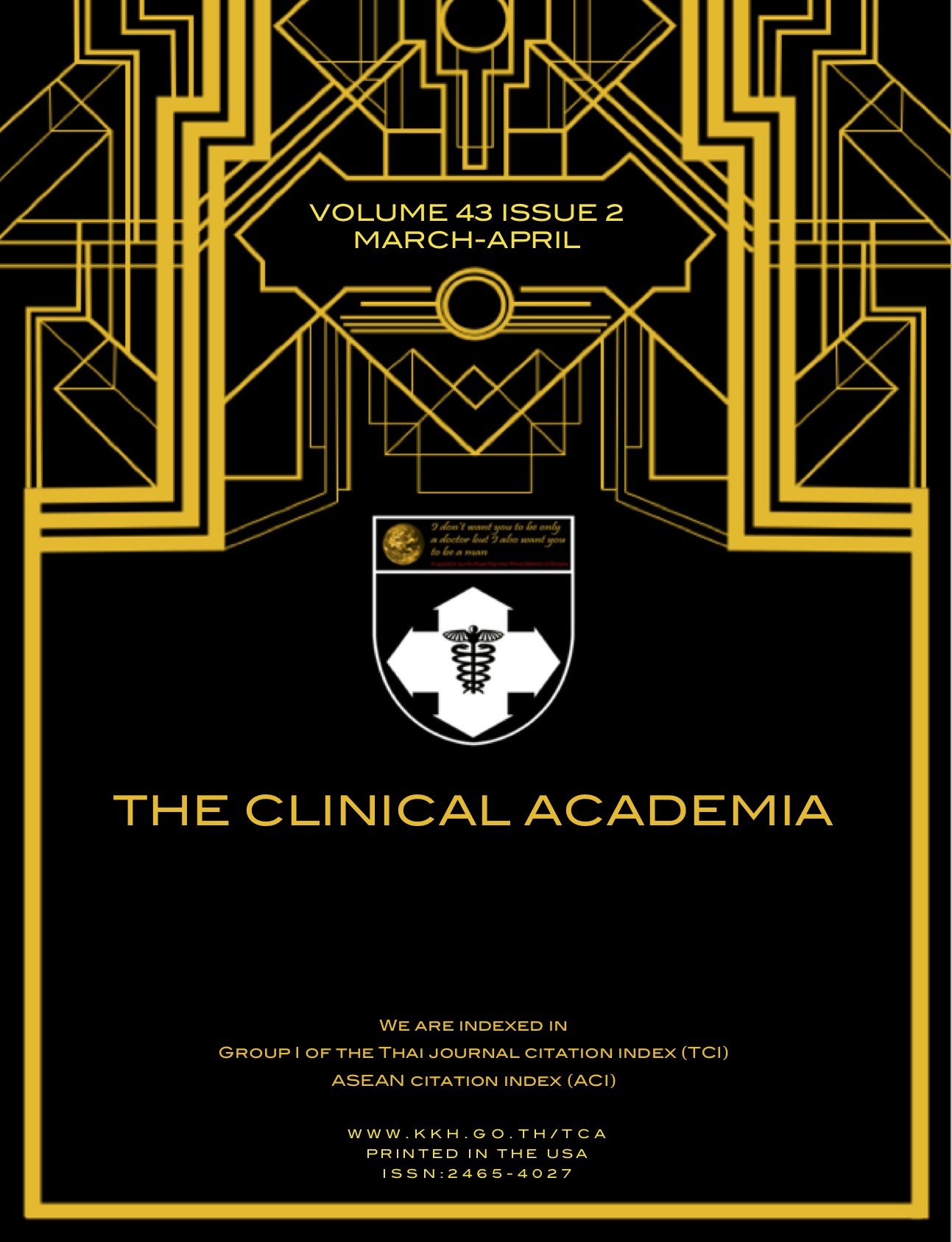Time intervals Influencing In-Hospital Delay in Treatment with Intravenous Thrombolysis in Stroke Fast Track
Abstract
OBJECTIVE
To determine the time intervals at the Emergency Department (ED) resulting in delayed thrombolytic therapy.
METHODS
This was a cross-sectional analytical study including 268 stroke fast track patients who admitted at ED of Khon Kaen Hospital, Thailand. Period of time for each patient was assessed before received thrombolytic drug. Door to needle (DTN) time more than 60 minutes was considered a delayed treatment. Time intervals that impact DTN time and accuracy of prediction were analyzed.
RESULTS
Of 88 with thrombolysis administration, there were 51 patients in the delayed group and 37 patients in the nondelayed group. The median DTN time was 75 minutes (interquartile range (IQR), 68 to 84) in the delayed group and 55 (IQR, 48 to 58) minutes in the non-delayed group. Final test to needle (FTN) time was the time interval that affected delayed treatment (adjusted odds ratio, 2.63; 95% confidence interval [CI], 1.33 to 5.13; P=0.005) and FTN time 34 minutes or longer had prognostic performance 90.4% (95% CI, 84.2 to 96.5), sensitivity 76.5% (95% CI, 62.5 to 87.2) and specificity 94.6% (95% CI, 81.8 to 99.3) to predict delayed thrombolysis administration.
CONCLUSION
In adults with acute ischemic stroke, FTN 34 minutes or longer was associated with the delay in thrombolysis administration
References
Campaign W. Facts and Figures - World Stroke Campaign [Internet]. Worldstrokecampaign.org.2017 [cited 7 November 2017]. Available from:http://www.worldstrokecampaign.org/learn/factsand-figures.html
The National Institute of Neurological Disorders and Stroke rt-PA Stroke Study Group. Tissue plasminogen activator for acute ischemic stroke. N Engl J Med. 1995;333:1581–1587.
Marler JR, Tilley BC, Lu M, Brott TG, Lyden PC, Grotta JC, Broderick JP, Levine SR, Frankel MP, Horowitz SH, Haley EC Jr, Lewandowski CA, Kwiatkowski TP. Early stroke treatment associated with better outcome: the NINDS rt-PA stroke study. Neurology. 2000;55:1649–1655.
Clark WM, Albers GW, Madden KP, Hamilton S;Thrombolytic Therapy in Acute Ischemic Stroke Study Investigators. The rtPA (alteplase) 0- to 6-hour acute stroke trial, part A (A0276g): results of a double-blind, placebo-controlled, multicenter study. Stroke. 2000;31:811–816.
Hacke W, Donnan G, Fieschi C, Kaste M, von Kummer R, Broderick JP, Brott T, Frankel M, Grotta JC, Haley EC Jr, Kwiatkowski T, Levine SR, Lewandowski C, Lu M, Lyden P, Marler JR, Patel S, Tilley BC, Albers G, Bluhmki E, Wilhelm M, Hamilton S; ATLANTIS Trials Investigators; ECASS Trials Investigators; NINDS rt-PA Study Group Investigators. Association of outcome with early stroke treatment: pooled analysis of ATLANTIS, ECASS, and NINDS rt-PA stroke trials. Lancet. 2004;363:768–774.
Jauch E, Saver J, Adams H, Bruno A, Connors J, Demaerschalk B et al. Guidelines for the Early Management of Patients With Acute Ischemic Stroke: A Guideline for Healthcare ProfessionalsFrom the American Heart Association/American Stroke Association. Stroke. 2013;44(3):870-947.
Ahmed N, Wahlgren N, Grond M, Hennerici M, Lees KR, Mikulik R, et al.; SITS investigators. Implementation and outcome of thrombolysis with alteplase 3–4.5 h after an acute stroke: an updated analysis from SITS-ISTR. Lancet Neurol. 2010; 9:866–874.
Adeoye O, Hornung R, Khatri P, Kleindorfer D. Recombinant tissue-type plasminogen activator use for ischemic stroke in the United States: a doubling of treatment rates over the course of 5 years.Stroke. 2011; 42:1952–1955.
Fonarow GC, Smith EE, Saver JL, Reeves MJ, Bhatt DL, Grau-Sepulveda MV, Olson DM, Hernandez AF, Peterson ED, Schwamm LH. Timeliness of tissue-type plasminogen activator therapy in acute ischemic stroke: patient characteristics, hospital factors, and outcomes associated with door-to-needle times within 60 minutes. Circulation. 2011 Feb 22;123(7):750-8.
Köhrmann M, Schellinger PD, Breuer L, Dohrn M, Kuramatsu JB, Blinzler C, Schwab S, Huttner HB. Avoiding in hospital delays and eliminating the three‐hour effect in thrombolysis for stroke. International Journal of Stroke. 2011 Dec;6(6):493-7.
Mikulík R, Kadlecová P, Czlonkowska A, Kobayashi A, Brozman M, Švigelj V, Csiba L, Fekete K, Korv J, Demarin V, Vilionskis A. Factors influencing in-hospital delay in treatment with intravenous thrombolysis. Stroke. 2012 Jun;43(6):1578-83.
Van Schaik SM, Scott S, de Lau LM, Van den Berg-Vos RM, Kruyt ND. Short door-to-needle times in acute ischemic stroke and prospective identification of its delaying factors. Cerebrovascular diseases extra. 2015;5(2):75-83.
Mohedano AI, Pastor AG, Arratibel AG, García PS, Otero FD, Delgado FR, Rubio RD, González AM, Alen PV, Bullido YF, Osorio JV. Factors associated with in-hospital delays in treating acute stroke with intravenous thrombolysis in a tertiary centre. Neurología (English Edition). 2016 Sep 1;31(7):452-8.
Qiang H, Qing-feng M, Juan F, Wei-yang C, Jian-ping J, Hai-qing S, Hong C, JianWu. Factors Associated with In-Hospital Delay inIntravenousThrombolysis for Acute Ischemic Stroke: Lessons from China. PLoSONE. 2015;10(11):1-9.
Ashkan M, Jordan D, Navdeep SL, Hamidreza RO, Christopher D, Peyman S, Marilou C, Annemarie C, Deborah AS, David J, Elad IL, Robert NS. Delays in door-to-needle time for acute ischemic stroke in the emergency department: A comprehensive stroke center experience. Journal of the Neurological Sciences. 2017;376:102–105.



